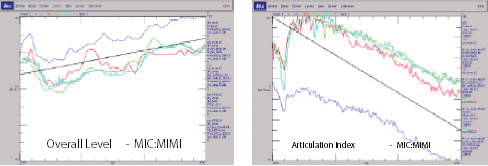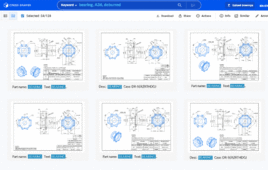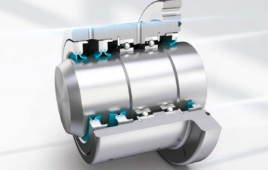By Kathryn Tomiello, Staff Editor
A lot of buzz has been circulating around Jiangling Motor Corporation (JMC) recently. The source – the first prototypes in a series of several new vehicles based on an Isuzu pickup and the Ford Transit commercial van. In fact, the Chinese government even had something to say about it. According to its regulations, the vehicles did not comply with Noise and Vibration standards.

The prototype vehicle underwent extensive indoor pass-by-noise tests on the LMS chassis dyno in a large semi-anechoic room. The measurements are highly repeatable over exterior pass-by noise measurements, and setup is quick.
When JMC contracted with LMS engineering consultants to fix the noise problem, it had two additional requirements: that LMS help its suppliers produce components and subsystems that comply with the Noise, Vibration, and Harshness (NVH) and pass-by noise standards, and that the company take into account constraints such as engine cooling, packaging, cost, durability, and the ability to manufacture.
During the initial phase of the project, LMS engineers identified how the interior trim contributed to noise and vibration by covering the interior panels with a dramatic absorption layer. Then they removed it from each panel in succession. They found that much of the interior noise came from the front floor, front door step, and other floor panels, as well as the vibration of the gearshift lever.

The engineers used virtual simulation to evaluate a range of alternative damping, isolation, and absorption options. The goal was to meet NVH requirements and minimize weight and manufacturing costs.
To reduce noise and vibration, they proposed adding damping layers to areas that produced excess sound, sealing at the junction between panels, foam to body pillars, and soft trim layers under the existing trim panels. The new design improved the articulation index by 30% with only a 3 kg increase in weight. It also reduced low-frequency noise.

The team performed several operational measurements on the vehicle, including 253 points on the drivetrain, rear suspension, floor, and body. The measurements helped them understand the dynamic deformations and critical resonances.
The project team used transfer path analysis (TPA) to determine which structure borne and airborne paths contributed most to interior noise. They identified and analyzed the main transfer paths, as well as the critical paths in detail. The team also analyzed local body stiffness at engine and suspension mounting locations to determine if they could improve upon the integration of these parts.

LMS engineers used transfer path analysis (TPA) to determine which structure borne and airborne paths contributed the most to interior noise.
What’s more, they needed to understand the behavior of the driveline and the suspension during harsh conditions. They performed operational deflection shape (ODS) analysis to identify dynamic deformations and crucial resonances. To capture deflections, they used small, lightweight accelerometers. The results were then visualized to understand the mechanisms behind the noise.

Overview of the pass-by noise test results of the original vehicle (blue) versus the different prototype vehicles transformed by LMS (red and green), and the target performance (black line).
The team made simple, non production-like modifications to stop the noise. These included adding a large mass to highly vibrating panels and covering sources that generated a lot of noise. They converted the most promising modifications into prototypes.

LMS engineers improved the existing engine undershield and developed a new gearbox undershield to reduce the direct gearbox contributions.
The TPA revealed a large 4th order contribution of the intake at 2,350 rpm, and the ODS indicated corresponding large vibrations of the body panel closest to the intake nozzle. Engineers added a mass to the body panel to verify whether the vibrating panel was contributing to the noise.


The LMS project team worked a complete sound package for the interior of the van including specific damping and insulation on the front floor, main floor, front roof, and front instep.
Their assumption was correct. On another vehicle, LMS redesigned the air intake to lower its contribution to the noise. The team used a boundary element acoustic model to analyze and improve the sound attenuations in the intake at the desired frequencies. Two resonators also significantly reduced low-frequency noise levels.
LMS mimicked pass-by noise level measurements on a semi-anechoic chassis dynamometer and used the airborne source quantification method to generate a detailed ranking of noise sources. The main contributors to pass-by noise came from the intake and exhaust nozzles, the exhaust manifold shell, and direct noise radiation from the engine and gearbox.
Additionally, rear muffler shell noise radiation produced a bothersome whistling sound upon pass-by.
Intake nozzle position, intake nozzle tube length and diameter, engine tube diameter, gearbox under-shielding, and the exhaust system were modified to meet regulatory requirements. The team reduced pass-by noise levels from 77 to 73 dB.
At the project’s end, LMS produced exactly what JMC wanted – a prototype vehicle that met regulatory requirements. It also addressed the company’s concerns about engine cooling, packaging, cost, durability, and the ability to manufacture. LMS took responsibility for modifying and testing vehicle prototypes to validate the design changes; and worked with JMC’s suppliers to make parts and subsystems that were compliant to NVH standards.
LMS North America
www.lmsintl.com
: Design World :
Filed Under: Automotive, Shocks + vibration control • gas springs





Tell Us What You Think!